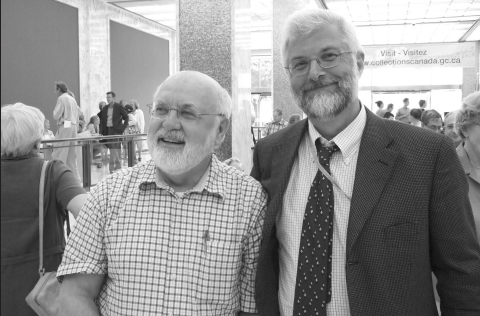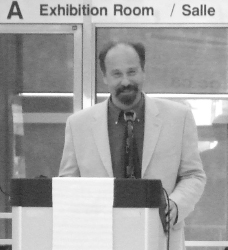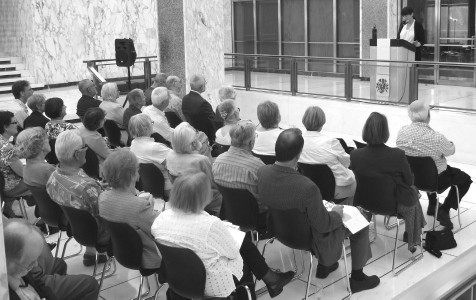 A standing-room-only
crowd of almost 100 people showed up in
A standing-room-only
crowd of almost 100 people showed up in By Borys Gengalo
 A standing-room-only
crowd of almost 100 people showed up in
A standing-room-only
crowd of almost 100 people showed up in
Peter DeLottinville,
Director of LAC’s Political and Social Division, reviewed Mr. Momryk’s long career
in the national archives, which included the receipt of the Queen’s Jubilee Medal.
In passing, DeLottinville mentioned this
was the third time he had spoken at an event honouring Myron’s work.
 The editors,
Dr. Rhonda Hinther, Head of Exhibits
Research at the
The editors,
Dr. Rhonda Hinther, Head of Exhibits
Research at the
“This volume
is dedicated to one of the great unsung heroes of Ukrainian Canadian scholarship:
Myron Momryk. In a career spanning for decades,
Myron has been a tireless advocate for multicultural history, an archivist and scholar
of Ukrainian and Canadian history, and perhaps most important, a mentor to entire
generations of scholars of ethnicity in Canada….”
The Master
of Ceremonies, Borys Gengalo, ended the formal portion of the event by reminding
the audience that Myron had collected not only Ukrainian materials, but those for
other East European groups in Canada as well, stating that he did much to save the
collective memory of a large segment of the Canadian population. The Ukrainian Canadian Congress had recognized
Momryk’s accomplishments by awarding him the Shevchenko Medal. Guests then gathered for informal discussion around
wine and cheese.
 Although
present, Mr. Momryk himself declined to speak at the launch, stating that the focus
should be on the book itself. Reimagining
Ukrainian Canadians is a collection of essays by thirteen Canadian historians,
most of Ukrainian descent, organized in five thematic sections. The whole is bounded by two short historiographic
essays from the editors.
Although
present, Mr. Momryk himself declined to speak at the launch, stating that the focus
should be on the book itself. Reimagining
Ukrainian Canadians is a collection of essays by thirteen Canadian historians,
most of Ukrainian descent, organized in five thematic sections. The whole is bounded by two short historiographic
essays from the editors.
Part 1, “New
Approaches to Old Questions,” begins with an essay by Hinther on the post-War generational
gap within the leadership of the Association of United Ukrainian Canadians. Going through it, the reader will identify very
familiar issues found across the full range of Ukrainian-Canadian organizations.
Karen Gabert’s work deals with how the founders
and developers of the
In Part 2,
“Leaders and Intellectuals,” Peter Melnycky presents the biography of Paul Rudyk,
a pioneering Ukrainian businessman and philanthropist. Jars Balan does much to publicize and refurbish
the reputation of Ukrainian-Canadian novelist Illia Kiriak. Orest Martynowych provides a nuanced and carefully
researched article on the attitudes of the leaderships of the Nationalist and Hetmanite
movements in
Part 3 is
titled “Diplomacy and International Concerns.” In it, Jaroslav Petryshyn examines
how the Ukrainian community in
In Part 4,
“Internal Strife on the Left,” Jim Mochoruk presents the history of the Stalinist
takeover of the Ukrainian left-wing organizations in the late 1920s and 1930s. Andrij Makuch describes the split caused by Danylo
Lobay within the Ukrainian Labour-Farmer Temple Association that resulted from that
takeover and the growing persecution of Ukrainians in the
Part 5, “Everyday
People,” begins with an essay by S. Holyck Hunchuck on
In a short
interview at the launch, Myron Momryk stated that “This is the book I’ve always
wanted to see.” He noted that the volume
not only deals with a broad range of Ukrainian-Canadian topics, but does so in a
different manner. The first generation of
historians tended to write from a particular community bias, seeking to gain acceptance
in Canadian society. The second generation
of historians, represented in this volume, takes a more analytic approach and is
not afraid to tackle the blank spots in our history that were regarded as untouchable
by the previous generation. Overall, this
thought-provoking book is definitely worthwhile reading for anyone who wants to
improve their understanding of the Ukrainian-Canadian experience.
Borys Gengalo is an active member of the Ukrainian community in
PHOTOS
1-
Myron
Momryk (L) shares a laugh with Peter De Lottinville, Director of the Political and Social Archives at LAC
2-
Co-editor
Prof. Jim Mochoruk addresses the crowd
3-
Co-editor
Dr. Rhonda Hinther speaks to the audience in atrium at LAC